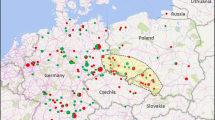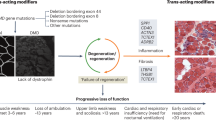Abstract
Recent studies documented an increased risk of neoplasm in patients with myotonic dystrophies (DM). Yet, none of these studies evaluated the contribution of common cancer risk factors in such observation. In this study, we included a cohort of patients (n = 255) with an established molecular diagnosis of DM type 1 (DM1), and who receives their treatment in one of the four centers with recognized expertise in neuromuscular disorders in Rome. We estimated the prevalence of benign and malignant tumors, and assessed if lifestyle factors and/or specific disease features would be associated to their occurrence. Overall, 59 benign tumors in 54 patients and 19 malignant tumors in 17 patients were diagnosed. The most common malignant neoplasms were cancers of the skin (31.6 %), thyroid (21.0 %), ovary (10.5 %), and breast (10.5 %). Uterine fibroid was the most common benign tumor (37.6 %) in women, while pilomatricoma was the most common in men (28.6 %). Age at enrollment (OR = 1.02, 95 % CI 1.00–1.05), and female gender (OR = 5.71, 95 % CI 2.90–11.22) were associated with tumor development in DM1 patients, while thyroid disorders was associated with malignant tumors only in women (OR = 5.12, 95 % CI 1.35–19.37). There was no association between tumor development and evaluated lifestyle factors. In conclusion, the lack of association between common cancer risk factors and tumor development in DM1 support a pathogenic link between tumors and DM1 itself, emphasizing the need for a systematic surveillance. Our observation of an association between thyroid diseases in women and cancer development needs confirmation.
Similar content being viewed by others
References
Ashizawa T, Sarkar PS (2011) Myotonic dystrophy types 1 and 2. Handb Clin Neurol 101:193–237
PS Harper (2001) Myotonic Dystrophy, 3rd edn. London
Cantwell AR Jr, Reed WB (1965) Myotonia atrophica and multiple calcifying epithelioma of Malherbe. Acta Derm Venereol 45:387–390
Street ML, Rogers RS 3rd (1991) Multiple pilomatricomas and myotonic dystrophy. J Dermatol Surg Oncol 17:728–730
Laredo Ortiz C, Munoz Romero F, Mallent Anon J, Domenech Miro E, Tafalla Pena M (1997) Multiple pilomatrixomas associated with Steinert disease. An Med Interna 14:409–411
Barberio E, Nino M, Dente V, Delfino M (2002) Guess what! Multiple pilomatricomas and Steiner disease. Eur J Dermatol 12:293–294
Gadalla SM, Lund M, Pfeiffer RM, Gørtz S, Mueller CM, Moxley RT 3rd, Kristinsson SY, Björkholm M, Shebl FM, Hilbert JE, Landgren O, Wohlfahrt J, Melbye M, Greene MH (2011) Cancer risk among patients with myotonic muscular dystrophy. JAMA 306:2480–2486
Win AK, Perattur PG, Pulido JS, Pulido CM, Lindor NM (2012) Increased cancer risks in myotonic dystrophy. Mayo Clin Proc 87:130–135
Mohamed S, Pruna L, Kaminsky P (2013) Increasing risk of tumors in myotonic dystrophy type 1. Presse Med 42:281–284
Das M, Moxley RT 3rd, Hilbert JE, Martens WB, Letren L, Greene MH, Gadalla SM (2012) Correlates of tumor development in patients with myotonic dystrophy. J Neurol 259:2161–2166
Gennarelli M, Pavoni M, Amicucci P, Novelli G, Dallapiccola B (1998) A single polymerase chain reaction-based protocol for detecting normal and expanded alleles in myotonic dystrophy. Diagn Mol Pathol 7:135–137
Modoni A, Silvestri G, Pomponi MG, Mangiola F, Tonali PA, Marra C (2004) Characterization of the pattern of cognitive impairment in myotonic dystrophy type 1. Arch Neurol 61:1943–1947
[No authors listed] New nomenclature and DNA testing guidelines for myotonic dystrophy type 1 (DM1). The International Myotonic Dystrophy Consortium (IDMC) (2000) Neurology 54:1218-21
AIRTUM Working group (2011) Italian cancer figures, report 2011: survival of cancer patients in Italy. Epidemiol Prev 35:1–200
Gadalla SM, Pfeiffer RM, Kristinsson SY, Björkholm M, Hilbert JE, Moxley RT 3rd, Landgren O, Greene MH (2013) Quantifying cancer absolute risk and cancer mortality in the presence of competing events after a myotonic dystrophy diagnosis. PLoS ONE 8:e79851
Okolo S (2008) Incidence, aetiology and epidemiology of uterine fibroids. Best Pract Res Clin Obstet Gynaecol 22:571–588
Lund M, Diaz LJ, Gørtz S, Feenstra B, Duno M, Juncker I, Eiberg H, Vissing J, Wohlfahrt J, Melbye M (2014) Risk of cancer in relatives of patients with myotonic dystrophy: a population-based cohort study. Eur J Neurol 21:1192–1197
Udd B, Krahe R (2012) The myotonic dystrophies: molecular, clinical, and therapeutic challenges. Lancet Neurol 11:891–905
Thornton CA (2014) Myotonic dystrophy. Neurol Clin 32:705–719
Mueller CM, Hilbert JE, Martens W, Thornton CA, Moxley RT 3rd, Greene MH (2009) Hypothesis: neoplasms in myotonic dystrophy. Cancer Causes Control 20:2009–2020
Santoro M, Masciullo M, Bonvissuto D, Bianchi ML, Michetti F, Silvestri G (2013) Alternative splicing of human insulin receptor gene (INSR) in type I and type II skeletal muscle fibers of patients with myotonic dystrophy type 1 and type 2. Mol Cell Biochem 380:259–265
Belfiore A, Malaguarnera R (2011) Insulin receptor and cancer. Endocr Relat Cancer 18:R125–R147
Perbellini R, Greco S, Sarra-Ferraris G, Cardani R, Capogrossi MC, Meola G, Martelli F (2011) Dysregulation and cellular mislocalization of specific miRNAs in myotonic dystrophy type 1. Neuromuscul Disord 21:81–88
Cheng Q, Yi B, Wang A, Jiang X (2013) Exploring and exploiting the fundamental role of microRNAs in tumor pathogenesis. Onco Targets Ther 6:1675–1684
Pallante P, Battista S, Pierantoni GM, Fusco A (2014) Deregulation of microRNA expression in thyroid neoplasias. Nat Rev Endocrinol 10:88–101
Schuler S, Ponnath M, Engel J, Ortmann O (2013) Ovarian epithelial tumors and reproductive factors:a systematic review. Arch Gynecol Obstet 287:1187–1204
Anderson KN, Schwab RB, Martinez ME (2014) Reproductive risk factors and breast cancer subtypes: a review of the literature. Breast Cancer Res Treat 144:1–10
Kim JJ, Chapman-Davis E (2010) Role of progesterone in endometrial cancer. Semin Reprod Med 28:81–90
Ørngreen MC, Arlien-Søborg P, Duno M, Hertz JM, Vissing J (2012) Endocrine function in 97 patients with myotonic dystrophy type 1. J Neurol 259:912–920
Srebnik N, Margalioth EJ, Rabinowitz R, Varshaver I, Altarescu G, Renbaum P, Levi-Lahad E, Weintraub A, Eldar-Geva T (2014) Ovarian reserve and PGD treatment outcome in women with myotonic dystrophy. Reprod Biomed Online 29:94–101
Acknowledgments
The work of Dr. Emanuele Leoncini was supported by Fondazione Veronesi. Dr. Shahinaz Gadalla is supported by the intramural program of the National Cancer Institute, Bethesda, MA.
Author information
Authors and Affiliations
Corresponding author
Ethics declarations
Conflicts of interest
The authors declare no conflict of interest.
Ethical standards
The study was designed in accordance with the guidelines of the Ethical Committees of the Università Cattolica del Sacro Cuore, University of Tor Vergata, University La Sapienza and Azienda Ospedaliera S.Camillo Forlanini, Rome Italy, and in agreement with the Declaration of Helsinki.
Rights and permissions
About this article
Cite this article
Bianchi, M.L.E., Leoncini, E., Masciullo, M. et al. Increased risk of tumor in DM1 is not related to exposure to common lifestyle risk factors. J Neurol 263, 492–498 (2016). https://doi.org/10.1007/s00415-015-8006-y
Received:
Revised:
Accepted:
Published:
Issue Date:
DOI: https://doi.org/10.1007/s00415-015-8006-y




